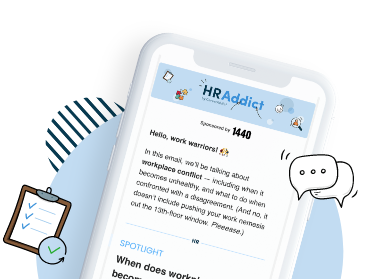You thought managing was a breeze, that your team were amazing — until that one problematic employee came along, right? At first, you thought they would slide right into the team seamlessly: they ticked all the right boxes, and they had the right skills and a confident attitude.
But the walls have slowly come crashing down, and you’ve discovered that they’re nothing but a Negative Nancy tearing down team morale with bad attitudes and lack of professionalism.
The truth is that most managers get held hostage by these disruptive employees, what with having to waste all their time and energy on them and not being able to bite the bullet and dismiss them for good.
Fortunately, we’re here to help! In this guide, we’ll show you how to deal with difficult employees in a diplomatic and effective way.
What is a difficult employee?
A difficult employee is someone whose behavior or work habits create challenges in the workplace — challenges that impact, among other things, team morale, productivity and even the company’s overall culture.
Simply put: difficult employees are a headache for any organization. They’re bad for business. Indeed, if left unchecked, they could expose the company to legal issues.
The three main types of difficult employees are:
- Bad performers: These difficult employees can exhibit a variety of traits, from tardiness to low productivity and misconduct to unethical behavior.
- Insubordinates: They openly defy authority and disobey orders, which can cause other employees to question your leadership capabilities.
- Ill-spirited: Known for their bad attitudes, they may be confrontational, chronic complainers or negative Nancys.
12 ways to deal with difficult employees
Got a difficult employee on your hands? These proven tips will help you change the situation around.
1. Recognize the problem
Although it might be a lot easier to just ignore the problem, hoping it will simply go away, you’ll need to face facts and recognize the issue by finding ways to confront the employee in question and solve the problem at hand.
By also taking on your destructive employee, you’ll send a message to your team that you’re a capable manager who won’t put up with anything other than hardworking, positive staff members.
2. Listen
When dealing with a difficult employee, you’ll most likely be inclined to switch off and not actually pay attention to what they’re saying. However, there may be an underlying issue to why they’re behaving the way they are, and in order to be able to manage the situation properly, you’ll need to have a conversation with them and listen carefully to what they have to say.
In some cases, employees act out because they feel as though their voice isn’t being heard, or there is someone else in the picture that could be the route of the problem. So, by simply listening to them, they’ll begin to feel valued and this can result in a change of attitude.
3. Observe
Before handling a complaint, it’s important to check out the situation for yourself and collect all the facts.
For example, you could monitor the employee over a period of time to determine whether their bad behavior was a one-time-only thing or if it’s a recurring problem. Often, it’s due to personal issues — and I’m sure there are days when you aren’t feeling 100% well, either!
4. Give constructive feedback
Although it can be really uncomfortable to give negative feedback, it’s important to do this in a constructive manner. Remember: don’t take it personally — or make it personal, for that matter!
Be sure to keep any advice you offer positive and to provide pointers that will help them improve their behavior and boost their productivity — without crushing their confidence in the process.
Meanwhile, if it’s something that can be addressed to the whole team, it might be better to call a team meeting where you can provide general tips to everyone. You could use specific examples of what the problematic team member has done, without actually calling them out. This should help them get the hint that they need to improve their methods without feeling like it was a personal attack on them.
5. Provide solutions
As a manager, you need to help your employee get back on track and improve in the areas they’re lagging. Remember: it’s your duty to help them create an action plan and provide easy-to-follow solutions.
You can begin by having a private meeting with them and create specific career goals for them. The next step is to come up with a step-by-step plan on how they can meet these targets, along with timeframes when these should be completed by.
Make sure you provide the right amount of training and that you check in on them on a regular basis to ensure they’re getting the attention they need and that they ultimately succeed.
6. Document everything
Throughout this process, it’s important to document everything.
If you’re providing additional training, be sure to follow up in writing to ensure there’s proof of the steps you’re taking to help the employee progress. It, hopefully, won’t come to letting them go, but in case it does, you’ll need a paper trail showing their lack of improvement.
7. Be consistent
When it comes to structure and discipline in the workplace, you need to be consistent at all times. For example, if you set a deadline for a project but allow some employees to turn it in a week or two later, it will encourage the less keen workers to follow suit.
Therefore, it’s important to develop clear instructions and targets, and make sure you stick to them without fail.
8. Set consequences
Now that you’ve learned how to set your plan, you can clearly monitor and manage the employee’s improvements. If you can see that they aren’t sticking to the plan, they lack motivation and they’re generally not putting in the effort, you need to set clear consequences, like giving them an official warning, for example.
You could say something like “I do believe you can turn this around if you give it your 100%; however, as I’ve not seen that kind of enthusiasm so far, you’ll be given a warning (or let go) if we don’t see any changes by [date]”.
9. Stick to the HR policy
When dealing with a difficult employee, it’s important to follow the rules by the book. And as a manager, you should speak to your HR department about any issues that arise in the workplace and come up with ways of handling these matters as professionally as possible.
Your HR manager will also be able to give you advice on how to coach your team member and try to get the best out of them. For example, you could provide them with positive feedback when they’re doing good and generally encourage them to keep going.
10. Follow up
Make sure you catch up with your employees regularly and set one-to-one meetings to check that they’re meeting the objectives that you set at the beginning of this process. If you start to flake, they will, too — so, it’s important to show your dedication to their advancement so they can match and exceed that determination.
11. Know when to fold
Unfortunately, sometimes an employee’s mentality just can’t be changed and they’re simply not good for the team and the overall morale. This is when terminating their employment — preferably on good terms — is the only solution.
Have a conversation with the employee in question to see whether they’re even happy in their role or if they too feel like it’s not working out for them.
12. Help them find a better-suited position
Sometimes, you may find that although the employee has great skills, they just aren’t suited for the role they’ve been given. In this case, you can help them move departments or even find a better position that they would enjoy more and be a lot more excited about.
If you can move them around in your team, then great! If not, do give them a lead for another position (if you have one).
Examples of difficult employee behaviors
So, what form do difficult employee behaviors take in the workplace? And how do you address them to create a thriving workplace culture? Let’s find out!
Gossip
Unfortunately, workplace gossip is a universal problem, and it can spell disaster not only for your company but also for other employees. Indeed, it can foster a negative culture, causing people to feel unsafe and bullied.
SOLUTION
Establish clear HR policies regarding workplace gossip — including the consequences. Meanwhile, provide employees with training, encouraging them to avoid engaging in this behavior and to speaking out and reporting any instances.
Manipulation
Manipulative employees are those who use fear, flattery, threats, lies and bribes to get what they want. They often abuse their power and influence for selfish reasons, which can create chaos in the workplace.
SOLUTION
Document noteworthy offenses, and take reports of any manipulative behavior seriously. Make it clear to the offending party that such behavior is not acceptable, and issue official warnings and take disciplinary action as needed.
Arrogance
While a healthy sense of self-confidence is important — and welcome — in any workplace, arrogant employees are generally entitled and uncooperative. Unfortunately, this can alienate others, resulting a toxic work culture.
SOLUTION
Try a direct — but non-confrontational — approach to address arrogant behavior in the workplace. Do this privately, and prompt the offender to consider the root causes of their behaviors and what alternatives would be better.
Nitpicking
A nitpicker is someone who works to perfectionistic standards. While this isn’t necessarily a bad thing, it certainly becomes a problem when it gets in the way of their work and that of their coworkers.
SOLUTION
Keep them on track, and help them see the bigger picture. Alternatively, you can tap into their nitpicking strengths and assign them tasks that could really make use of their perfectionism.
Sabotage
Saboteurs are lying, deceptive creatures who can cause serious damage to your company, whether that’s misappropriating company property or setting up people for failure.
SOLUTION
Ask employees and managers to report suspicious activities, and document these in detail. Seek legal counsel for appropriate steps to take, and get the relevant authorities involved when necessary.
Final thoughts
Dealing with a difficult employee is not going to be easy, but as a manager, it’s part of your responsibilities. And with the proven tips highlighted above, you’ll be able to tackle the issue before things get out of hand, all the while knowing that you have helped them as much as you could.
Have you ever dealt with a tricky employee before? If so, join in on the conversation below and share your story with us.
This article is a partial update of an earlier version originally published in 2013.

